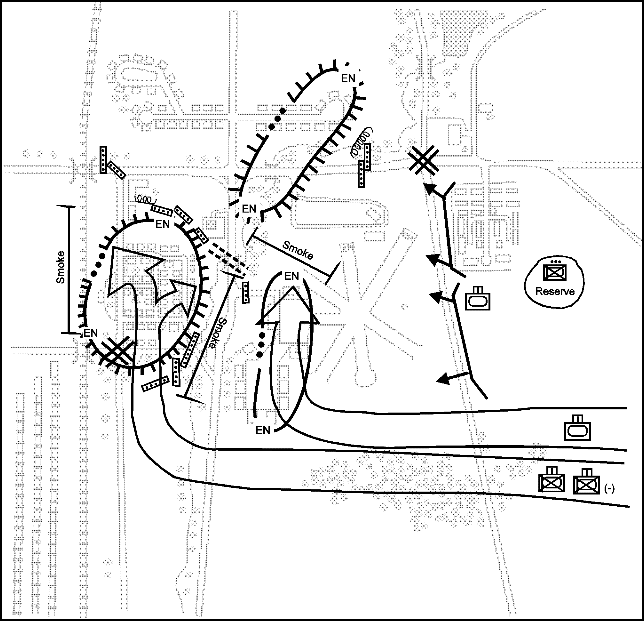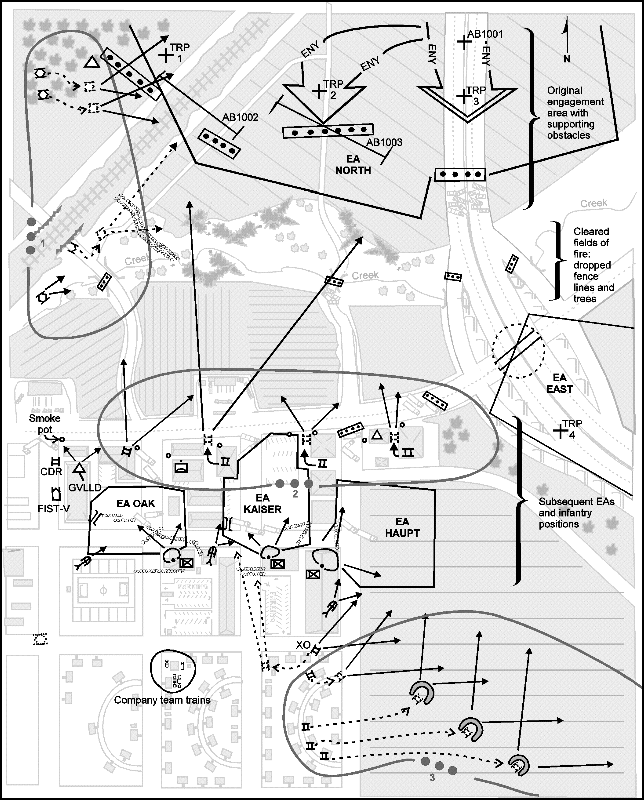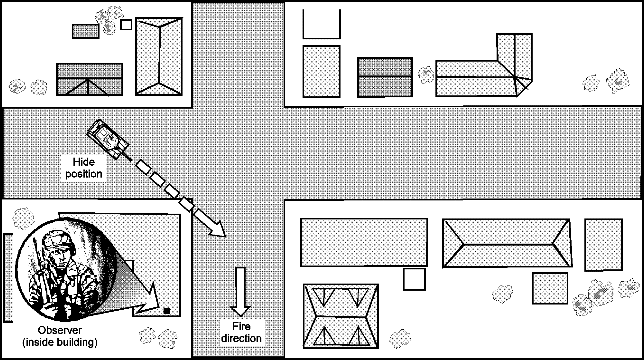APPENDIX I Military Operations in Urban TerrainThe company team may take part in large-scale urban combat operations as part of a larger force. The team may also have to conduct MOUT when maneuvering separately; situations might include enemy contact in a very small village (10 or fewer buildings) or in a lateral strip area (along a road or highway). This appendix examines the basic characteristics of MOUT as well as special planning considerations and techniques of offensive and defensive operations. For more detailed information, refer to FM 90-10 and FM 90-10-1. |
|||
CONTENTS
|
|||
SECTION 1 - MOUT PLANNING CONSIDERATIONS |
|||
Built-up areas consist mainly of man-made features such as buildings, streets, and subterranean systems. These features of urban terrain create a variety of tactical problems and possibilities. To ensure the company team can operate effectively in the MOUT environment, the team observation and direct fire plans must address the ground-level fight (in streets and on the ground floor of buildings), the aboveground fight (in multistoried buildings), and the subterranean fight. The following considerations apply:
|
|||
<>
Figure I-1. Underground systems.
As described in the following paragraphs, numerous factors related to vehicles and equipment affect the company teamís MOUT planning and execution. |
|||
M1-series tanks |
The following factors may affect MOUT:
|
||
BFVs |
The following factors may affect MOUT:
|
||
Figure I-2. Tank weapon dead space at street level.
Figure I-3. Tank cannon and coax machine gun dead space above street level.
The following command and control considerations will affect the company teamís MOUT planning and execution:
|
|||
The following factors related to maneuver will affect the company teamís MOUT planning and execution:
|
|||
The MOUT environment will affect how and when indirect fires will be employed. The following factors may have an impact on planning and execution:
|
|||
Guidelines for providing effective CSS to units fighting in built-up areas include the following:
|
|||
SECTION 2 - OFFENSIVE MOUT |
|||
Offensive operations in a built-up area are planned and executed based on the factors of METT-TC and established doctrine. This section focuses on the unique problems and challenges that offensive MOUT pose for the company team. |
|||
At the task force level, the MOUT offense takes the form of either a hasty or deliberate attack. Both types of attack require the friendly force to conduct as much planning, reconnaissance, and coordination as time and the situation permit. |
|||
Hasty attack |
Task forces and company teams conduct hasty attacks as a result of meeting engagements, when unexpected contact occurs and bypass has not been authorized, or when the enemy is in a vulnerable position and can be quickly defeated through immediate offensive action. The following special considerations apply for hasty attacks in the MOUT environment:
|
||
Deliberate attack |
A deliberate attack is a fully integrated operation that employs all available assets against the enemyís defense. It is employed when enemy positions are well prepared, when the built-up area is large or severely congested, or when surprise has been lost. Deliberate attacks are characterized by precise planning based on detailed information and reconnaissance and thorough preparations and rehearsals. Given the nature of urban terrain, the techniques employed in the deliberate attack of a built-up area are similar to those used in assaulting a strongpoint. The attack avoids the enemyís main strength, instead focusing combat power on the weakest point in the defense. A deliberate attack in a built-up area is usually conducted in four phases: reconnoiter the objective, isolate the objective, secure a foothold, and clear the built-up area. The following discussion examines these phases in detail. |
||
Reconnoiter the |
The reconnaissance phase of MOUT must provide the company team and other friendly elements with adequate intelligence to stage a deliberate attack. This can pose a variety of problems and challenges since the intelligence not only must be extremely detailed but also must generally be collected from outside the urban area to ensure the survivability of the scouts. Detailed maps of the area of operations must be distributed to the lowest level. |
||
Isolate the objective |
Isolating the objective involves seizing terrain that dominates the area so the enemy cannot supply or reinforce his defensive forces. This step may be taken at the same time as securing a foothold. If isolating the objective is the first step, the subsequent steps should be carried out quickly so the defender has no time to react. |
||
Secure a foothold |
Securing a foothold involves seizing an intermediate objective that provides attacking forces with cover from enemy fire as well as a place at which they can enter the built-up area. For the company team, a foothold is normally one to two city blocks. As the team attacks to secure the foothold, it should be supported by direct and indirect suppressive fires and by obscuring or screening smoke. |
||
Clear the built-up area |
In determining the extent to which the built-up area must be cleared, the commander of the attacking force must consider the factors of METT-TC. He may decide to clear only those parts of the area necessary to the success of his mission if any of the following factors apply:
On the other hand, the attacking unit may have a mission to systematically clear an area of all enemy forces. Through detailed analysis, the commander may anticipate that the unit will be opposed by a strong, organized resistance or will be operating in areas where buildings are close together. In such a situation, one or two company teams may attack on a narrow front against the enemyís weakest sector. The teams move slowly through the area, clearing systematically from room to room and building to building. Other maneuver elements support the clearing teams and are prepared to assume their mission as necessary. |
||
The task organization of a company team conducting an attack during MOUT will vary according to the specific nature of the built-up area and the objective. In general, the team will employ an assault force, a support force, and a reserve; in some cases, a security force is also used. Normally, there is no separate breach force; however, breaching elements may be part of the assault or support force, depending on the type and location of anticipated obstacles. |
|||
Support force |
Normally, most mounted elements of the MOUT unit are task organized in the support force. This allows the task force or company team commander to employ the firepower of the fighting vehicles without compromising their survivability, a distinct danger when heavy forces move into an urban area. The support force isolates the area of operations and the actual entry point into the urban area, allowing assault forces to secure a foothold. |
||
Assault force |
The assault force is the element that gains a foothold in the urban area and conducts the clearance of actual objectives in the area. This force is normally a dismounted element task organized with engineers, with specific augmentation by armored vehicles. |
||
Reserve force |
The reserve force normally includes both mounted and dismounted forces. It should be prepared to conduct any of the following tasks:
|
||
During the attack of a built-up area, tanks and BFVs may support by fire while lead elements are seizing a foothold. They then provide overwatch or serve as a base of fire for the infantry until the area has been secured. |
|||
Role of tanks |
The commander must employ tanks and BFVs to take advantage of their long-range lethality. He can usually do this by positioning the armored vehicles outside the built-up area, where they remain for the duration of the attack to cover high-speed avenues of approach. This is especially true during the isolation phase. (NOTE: Before providing support for the attack, tanks and BFVs must be able to maneuver into overwatch or base of fire positions; this will normally require support from organic infantry weapons to suppress enemy strongpoints and ATGM assets.) |
||
Mutual support |
In house-to-house and street fighting, tanks and BFVs move down the streets protected by the infantry, which clears the area of enemy ATGM weapons. The armored vehicles in turn support the infantry by firing their main guns and machine guns from a safe standoff range to destroy enemy positions. (NOTE: Refer to Figures 3-24 and 3-25 for an illustration of the mutual overwatch techniques that are required during combined operations in restricted areas.) Figure I-4 illustrates a task force attack in a MOUT environment. |
||

Figure I-4. Example task force attack in a MOUT environment.
SECTION 3 - DEFENSIVE MOUT |
|||
Like offensive MOUT, defensive operations in a built-up area require thorough planning and precise execution based on METT-TC and established doctrine. This section examines MOUT considerations that affect the company team in the defense. |
|||
While positioned in an urban area, the company team may be tasked to defend against an enemy approaching from outside the area. In general, procedures and considerations are the same as those for defensive operations in open terrain. For example, the commander designates BPs that take advantage of all available weapon systems. Objectives are similar as well; these may include preventing the enemy from isolating the defensive position, conducting reconnaissance of the defensive position, and/or gaining a foothold in the urban area. This type of MOUT may transition into an in-depth defense of the urban area, as described in the following paragraph, if the attacker continues to commit forces to the battle and the defending force fails to divert or destroy them. |
|||
The company team may be called upon to conduct any of several types of defensive operations (including defend in sector, defend a strongpoint, and defend a BP) when it faces enemy forces within the urban area. Procedures and considerations for these defensive operations are generally similar to those used in more conventional open terrain situations. The commander should designate engagement areas that take advantage of integrated obstacles and urban terrain features and that can be covered by direct and indirect fires. Figure I-5 illustrates defensive MOUT. |
|||
Role of tanks |
In the defense, tanks and BFVs provide the MOUT commander with a mobile force that can respond quickly to enemy threats. They should be located on likely enemy avenues of approach in positions that allow them to take advantage of their long-range fires. Effective positioning allows the commander to employ the armored vehicles in a number of ways, such as the following:
Tanks and BFVs are normally employed as a platoon. The commander also has the alternative of employing sections or individual armored vehicles with infantry platoons and squads; this allows tanks and BFVs to take advantage of the close security provided by the infantry. |
||

Figure I-5. Example company team defense in a MOUT environment.
Fighting positions |
Fighting positions for tanks and BFVs are an essential component of a complete and effective defensive plan in built-up areas. Vehicle positions must be selected and developed to afford the best possible cover, concealment, observation, and fields of fire; at the same time, they must not restrict the vehiclesí ability to move when necessary. The following considerations apply:
|
||

Figure I-6. Example vehicle hide position in a MOUT environment.
Employment of |
Infantry squads are usually employed abreast so that they all can fire toward the expected direction of attack. In the company team, however, the limited number of available infantrymen may require squad positions to be interspersed with vehicle positions. In built-up areas, squads may be separated by rooms within a building, or they may be positioned in different buildings. Infantry positions must be mutually supporting and allow for overlapping sectors of fire, even when they are in separate buildings or are divided by walls. |
||
Employment of |
The commanderís defensive scheme of maneuver in MOUT must always include the employment of a reserve force. This force should be prepared to counterattack to regain key positions, to block enemy penetrations, to protect the flanks of the friendly force, or to provide a base of fire for disengaging elements. For combat in built-up areas, the reserve force has these characteristics:
|
||